Value Dance Quilt tutorial
This tutorial series is part of the Value Added Quilt Along. Visit my intro post for links to all the lessons on using value in quilt design.
Today I'll show you have to assemble and finish your Value Dance quilt! This is Part C. You can find the previous installments at Part A and Part B. See Part A for fabric requirements.

Finishing Value Dance
Step 1: Layout Patchwork
After Parts A and B, you should have 40 each of hourglass blocks and on point square blocks. To begin assembling the patchwork portion of this quilt, lay out all 80 blocks as shown:
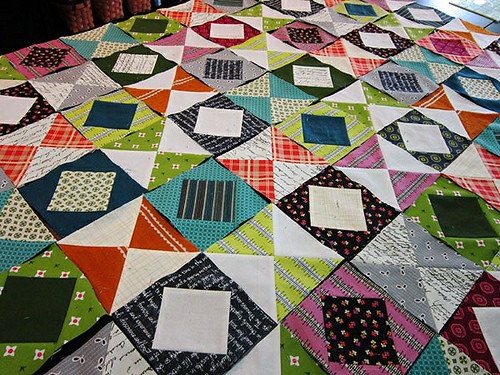
Notice that the darker portion of each hourglass block should touch a dark-center on point square block. Conversely, the lighter portion of each hourglass block should touch a light-center on point square block.
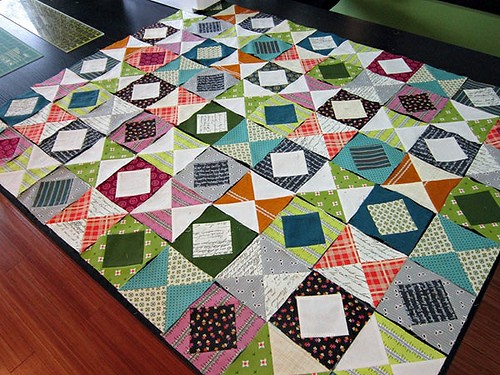
Here I've laid out all 80 blocks in a 8 x 10 arrangement (10 columns of blocks, with 8 blocks each). The value pattern layout creates a grid with all dark-center squares in rows and all light-center squares in rows. I choose to lay out all blocks at once and then move them here and there to assure that all prints are nicely scattered.
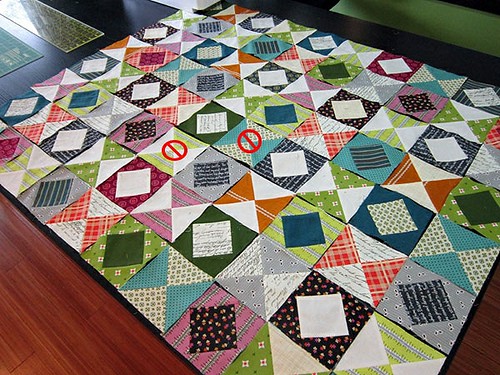
There were 2 misplaced hourglass blocks in my layout at the time of this photograph. I've labeled them here. Happily I fixed them before assembling. It pays to double-check as you're piecing!
Step 2: Assemble Patchwork
In order to maintain the proper order of blocks, sew blocks together in pairs. Work with one column at a time, chain-piecing to save time and maintain block order. Press seams open while blocks are still connected. Then, return to your layout with pressed blocks, snipping chain-pieced connections as you return the blocks to each place. I have to really pay attention at this point to keep everything in order! Checking value relationships as you place each block helps.

Now you'll have a bunch of block pairs, like so.

Join the pairs into 4-block sets.
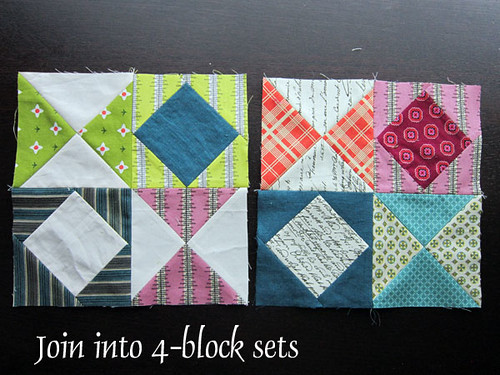
In each set, you'll have 2 hourglass blocks and 2 on point square blocks (one with a light-center square and one with dark-center square). This is the basic building block of our Value Dance patchwork. Your 4-block sets can be rearranged on the quilt top without disturbing the value relationships. So (if you're like me) do one last check at this point to see if you want to move any blocks!
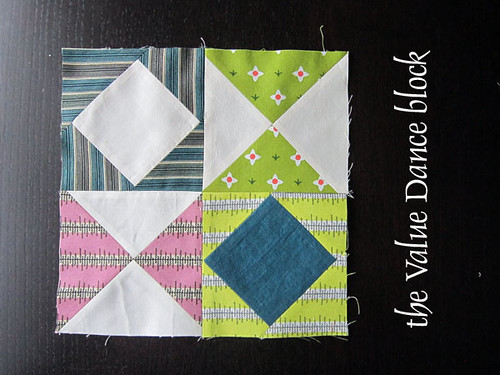
Last of all, join blocks into columns and then join columns to complete the patchwork. At this point your quilt top should measure 36.5" x 45.5".
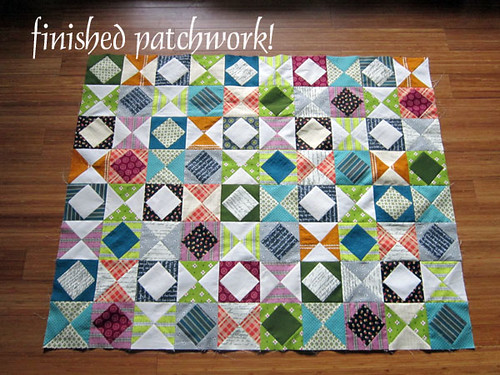
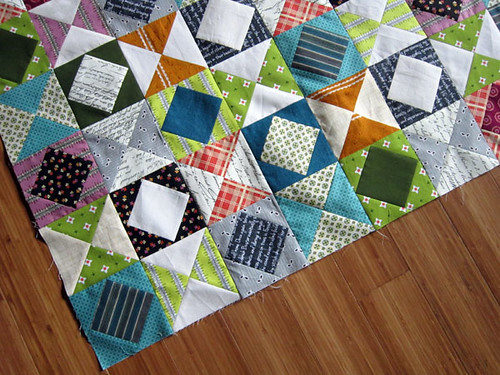
Step 3: Add Borders
The patchwork center is surrounded by 3 borders. Border 1 is a dark value border (I used solid teal) and requires a 1/2 yard. Border 2 is a light value border (I used a white text print) and requires a 1/3 yard. Border 3 can be a medium value or multi-colored print to tie your quilt together and requires 1 yard.
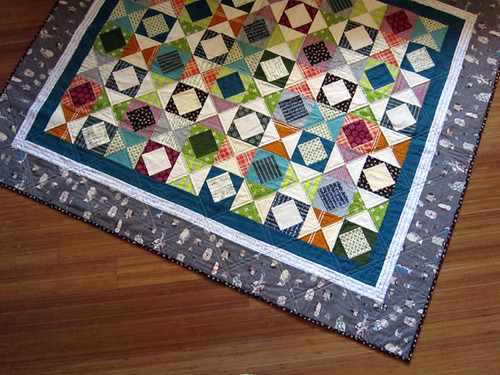
When sewing long border strips, I use a walking foot to maintain an even feed so that the border is attached smoothly without ripples. I don't usually pin my borders at all, but simply feed a longer-than-necessary border strip onto the edge of my work-in-progress. Another way to ensure smooth borders is to pin the border in place. Start pinning from the center out, smoothing the border strip away from center as you pin.
I don't like to measure quilt sides and then cut border strips to a matching length. Instead, I prepare a longer-than-necessary border strip and sew. After pressing seams open, I trim the border to length, using the edge of the quilt as a guide for a 90 degree angle. The following instructions call for longer-than-necessary border strips. Trim after pressing and before proceeding to sew the next step.
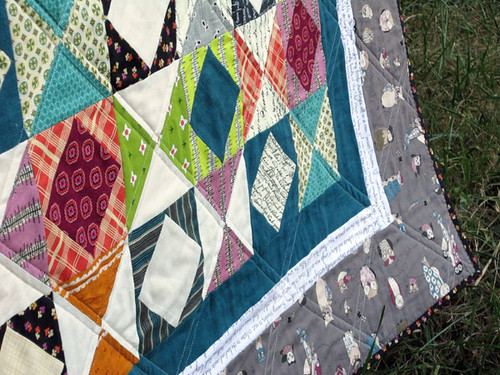
For Border 1, cut (5) width-of-fabric (WOF) 2.5" strips. You should have (5) 2.5" x 44" strips. Cut (2) 5" pieces from one strip. Lengthen two of the other strips by sewing a 5" piece onto each of them at one end. Attach these longest strips to the longest sides of your patchwork center. Press seams, trim and then attach remaining WOF strips to the remaining raw edges of the patchwork center, completing this border.
For Border 2, cut (5) WOF 2" strips. Sew 2 strips to the shortest sides of your work-in-progress. Press seams and trim excess borders to a 90 degree angle at corners. Then, cut one WOF strip in half, creating (2) 2" x 22" strips. Lengthen two of the other strips by sewing a 22" piece onto each of them at one end. Attach these longest strips to the remaining sides of your work, completing this border.
At this point, your work-in-progress should measure 43.5" x 52.5". If it's slightly bigger or smaller that's ok. I don't measure my quilts while in process! But, it's a good idea to make sure that your corners are nice and square. Use a ruler to trim them to a 90 degree angle, if necessary, before adding the final wide border.
For Border 3, cut (6) WOF 5.5" strips. Cut two WOF strip in half, creating (4) 5.5" x 22" strips. Lengthen all of the other strips by sewing a 22" piece onto each of them at one end.
Sew 2 strips to the longest sides of your work-in-progress. Press seams and trim excess borders to a 90 degree angle at corners. Attach last strips to the remaining sides of your work, completing the quilt top!
Step 4: Finishing
For a whole cloth backing, you'll need 3.5 yards. Batting required at 55" x 64". For binding, you'll need a 1/2 yard.
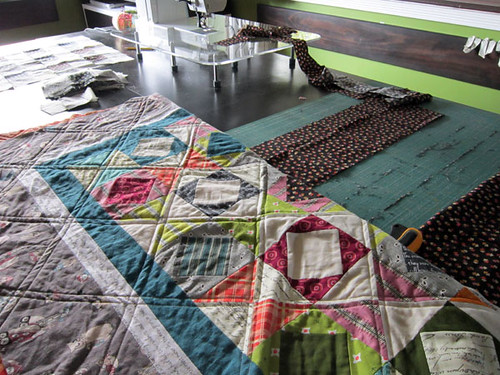
Of course, you'll quilt as desired! I chose to quilt lines at 1/4" on either side of the diagonal hourglass seams. This quilting pattern emphasizes the larger square-in-square blocks that are created as the hourglass and on point squares merge.

I backed my quilt with delicious Chicopee corduroy and finished with quick, effective zigzag binding. If you haven't tried machine binding before, the zigzag method produces attractive results front and back without requiring lots of practice. Give it a go with my tutorial!
Thanks for sewing with me! I hope you enjoyed it!